10 Types of Limes to Enhance Dishes & Excite Mouths
Author: Anne Cowart | Editor: Omar Alonso
Review & Research: Jen Worst & Chris Miller

Members of the citrus fruit family, different types of limes are used around the world in many ways and recipes to elevate flavors to a whole new level. What you might not have known is that limes exist in a wide range of shapes, sizes, and even colors.
The different limes across the world have slightly varying tastes along with their looks. We have talked in depth about all the kinds of limes over here so that you have a better idea of which lime to use when.
10 Types of Limes
Here's some interesting lime trivia for you before we get started. Limes are native to southeastern India. Before the lime grows, fragrant white flowers first appear. What you find in the stores in the U.S. are Persian limes (seedless) or Key limes (seeded). Limes first reached the West when Columbus brought them over in 1493, carrying them to prevent scurvy.
Each lime in this list below can be used for a different purpose in cooking, so read closely to know which limes tantalize your taste buds the most.
Key Limes
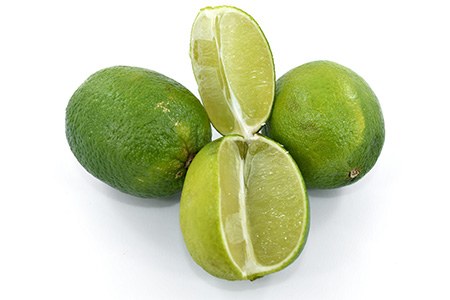
This type of lime is extremely common and is found in most parts of the world. They start with green skin, which gradually turns yellow as they grow.
Key limes are also known as Mexican limes or even West Indian Limes. These limes are native to Southeast Asia but are now grown all over the world.
In terms of flavor, key lime varieties have a very acidic taste with a slightly bitter after taste. But to make things better, it also has a wonderful aroma, which can be a great addition to any savory dish.
Additionally, they are very juicy, meaning you will be able to extract enough juice from one lime for your whole dish, especially if you use any types of juicers rather than squeezing by hand.
These bright yellow limes are not very large, but not the smallest limes out there. In fact, they grow to a range of about 2.5 to 5 cm in diameter, which is around 1 to 2 inches.
You will also find that key limes have plenty of small seeds inside of them. Thus, when you are juicing it, make sure to take out the seeds before you add them to anything. You can even turn the remaining fruit into types of pickles.
Persian Limes
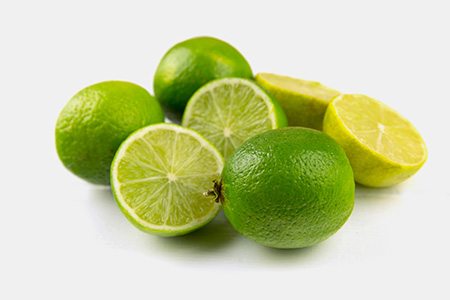
You might have heard of these types of limes before because it is very popular but might not have known because it goes by many names: Bearss lime, Tahiti lime, and the most common seedless lime. It can be said that Persian limes are sort of a hybrid fruit of lemon and limes.
Bearss limes are larger than key limes and have an average diameter of 2.5 inches or 6 cm. They start off with green skin, but as they ripen more and more, it becomes yellowish-green. The rind of this lime, as well as the outer skin, is thin, and the skin is also smooth, making it easier to zest.
This lime is not as acidic and bitter as key limes, but it has a wonderful distinct tart taste. It compliments dishes very well, so you can use it instead of vinegar for your salads. Since they taste very nice, they are used worldwide in many dishes.
Last but not the least, as implied by its name 'seedless lime,' this lime doesn't have any seeds on the inside and is also quite juicy, which makes juicing a breeze.
Castelo Limes
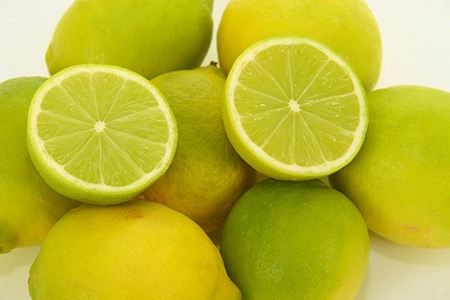
Castelo limes are likely ones you haven't had the opportunity to enjoy, due to it being rare in areas that aren't near South America. It's considered an Indo-Malayan lime and is on average bigger than the other types of limes.
Once it grows to about 6 centimeters in diameter and turns into a light yellow, you'll know it's ripe and mature, ready for the tasting. You won't find that it's an unfamiliar taste.
You'll be able to enjoy the harvest between fall and winter in your key lime pies (it can be swapped out with key limes since they have a similar flavor in terms of sweetness and tartness).
Kaffir Limes
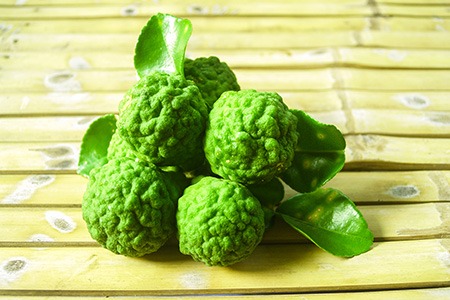
Kaffir limes were first grown in the tropical areas of South Asia as well as South China. Along with the limes, the leaves on this tree are also used in numerous ways, such as in cooking and even in the making of essential oils.
The acidic taste in Kaffir limes (also called Makrut Limes) is extremely strong, which is why they are never eaten raw. They are not generally used by juicing because they are not very juicy at all. Instead, these limes are sliced into thin slices to add to soups or curries in the right proportions.
As we have mentioned before, the leaves from Kaffir lime trees and Kaffir lime zest are also used to get more flavor in dishes; they are especially used in Asian cuisines.
In terms of looks, the rind of the Kaffir lime has a very interesting rough and bumpy texture which is quite uncommon. They are green in color and aren't big, with an average diameter of 4 cm or 2 inches.
Finger Limes
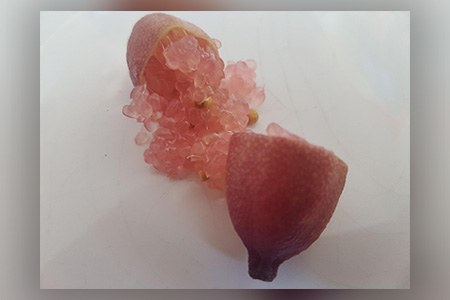
If you think limes only come in spherical shapes, then finger limes are here to change your mind. The shape of this lime is like a much more elongated lime; you could say it looks like a small gourd or even a sausage. They are neither very small nor big; their length varies from around 6 to 12 cm.
Finger limes are also commonly known as caviar limes because on the inside, the juice is in small caviar-like shapes.
The flesh of the caviar lime has a delicious flavor that resembles the flavor of a grapefruit while also having a lemon-like kick to it. On the other hand, its skin has the same taste as regular lime.
These limes are native to Australia, and more specifically, are grown in Southeast Queensland as well as in New South Wales. They usually ripen around winter and so are collected and preserved during that time for future use.
Key limes are grown in small shrubs which have a lot of thorns, and the fruits come in different colors, which include brown, red, green, yellow, and even black. But they are the same types of limes despite the color differences.
Omani Limes
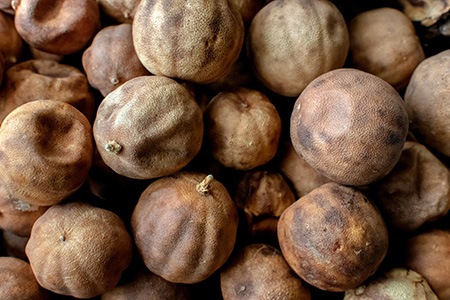
Hailing from the country Oman in the Middle East, this is another of the different limes you may not have tried because they're not very sweet and they're smaller with a very potent aroma and flavor.
People use these tart fruits generally in tea or as one of the types of spices. In both cases the Omani lime varieties are peeled and the peels are dried and used for the separate applications.
Blood Limes
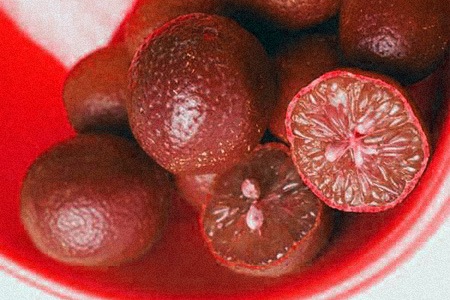
You are probably very intrigued by the name of this lime, 'blood lime.' As you can probably tell by its name, this lime has very beautiful red skin. This lime is a hybrid fruit of red finger lime and a type of mandarin hybrid.
Blood limes are not completely spherical, they have a shape that is very similar to that of an egg. They are also quite small, with an average diameter of 2 cm or 0.8 in and a length of 4 cm or 1.6 in.
The flesh of blood limes is in a pearl-like form, and the inside of the fruit also has a lot of juice. Since the blood lime is a hybrid lime fruit, it has a very unique flavor. It has a bittersweet taste similar to a grapefruit while also having a wonderful tart flavor.
Hence, blood types of limes are often used in making sauces and are also used in making some delicious desserts.
Philippine Limes
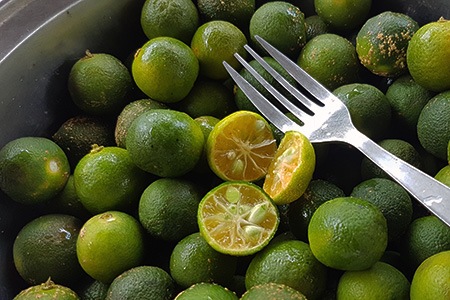
Philippine limes often go by the name Calamansi limes, and as blood and key limes is also a hybrid lime fruit. These limes are pretty tiny, with their diameters ranging from 2.5 to 3.5 cm or 1 to 1.4 inches. They begin their life with the green outer skin, but as they ripen, they become orange.
However, we must mention that these limes are usually picked while they are still green because when they turn orange, the insides are a bit too ripe. Thankfully in an orchard of all lime trees instead of many types of fruit trees, it's easy to watch over the colors.
The orange flesh of the calamansi limes is quite different from other limes, and the juice from this lime tastes very acidic. Meanwhile, the rind of calamansi limes turns sweet as they become fully ripe.
Although there are tropical places where this lime is grown, it is most popular in the Philippines along with South Asia. You can use the peels of these and other kinds of limes as types of garnish when grated.
Rangpur Limes

Also known by the name Mandarin lime, these different limes are yet another product of cross-pollination. You could say that the Rangpur lime is a hybrid of lemons and tangerines. Both the skin and the flesh of this lime are orange, which makes it look very similar to mandarin oranges and other orange types.
Since this type of lime is a hybrid of lemon and tangerine, it has a strong tart taste which resembles the taste of a regular lime but also has a unique aroma. The Mandarin lime is commonly used to make marmalades which are then enjoyed by spreading over a piece of bread.
Limequats
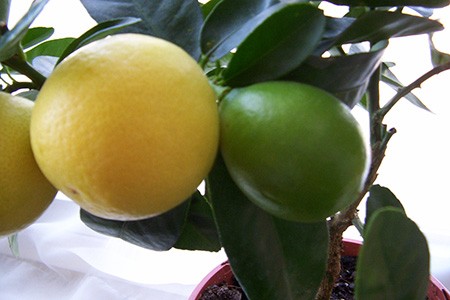
Yet again, these lime varieties are also a hybrid lime fruit. It is the result of the cross-pollination of key limes and kumquats. Limequats are quite small, with their diameter ranging from 3 to 4 cm, and they have an oval shape.
In terms of taste, this type of lime has a bitter-sweet pulp while skin which actually has a sweet taste to it. Since the skin has a nice taste, you might have this lime as a whole fruit. Besides that, you can juice it and add the juice to drinks or dishes for more flavor.
Limequat trees are usually grown in Spain, the United States, Malaysia, and Japan. However, they can also be grown in many different countries because they are very tough and can even handle cool climates down to 10 degrees.
Other Types of Limes
There are quite a number of different types of limes out there, but not all of them are easy to grow, easy to transport, or easy to cook with. Many also have strange flavors or are too pungent and strong to enjoy. Most are hybrids that aren't that unique, either.
These other types of limes can include (with additional names in parenthesis):
- Merdeka Limes
- Kalamansi Limes (Musk Limes & Calamondin Limes)
- Mary Ellen Sweet Limes
- Winged Limes
- Limetta Palestinian Sweet Limes
- Kusaie Limes
- Ginger Limes
- Australian Desert Limes
- Millsweet Limetta
There's also the Lemon-Lime Tree which is a single tree that grows both lemons and limes. The tree is a mix between the key lime tree and the Meyer lemon tree. You can save some space in your garden in this way if you want a more "standard" lime variety. You can also look into growing "lime" types of basil.
Types of Limes for Every Subtle Flavor Profile
From the bittersweet flavor of blood limes to the strong acidic taste of kaffir limes, limes have a wide range of flavors that are excellent for cooking and baking.
The richness in the different types of limes across the world is truly surprising, and one should try each of these limes to get a taste of the nature of different parts of the world.




